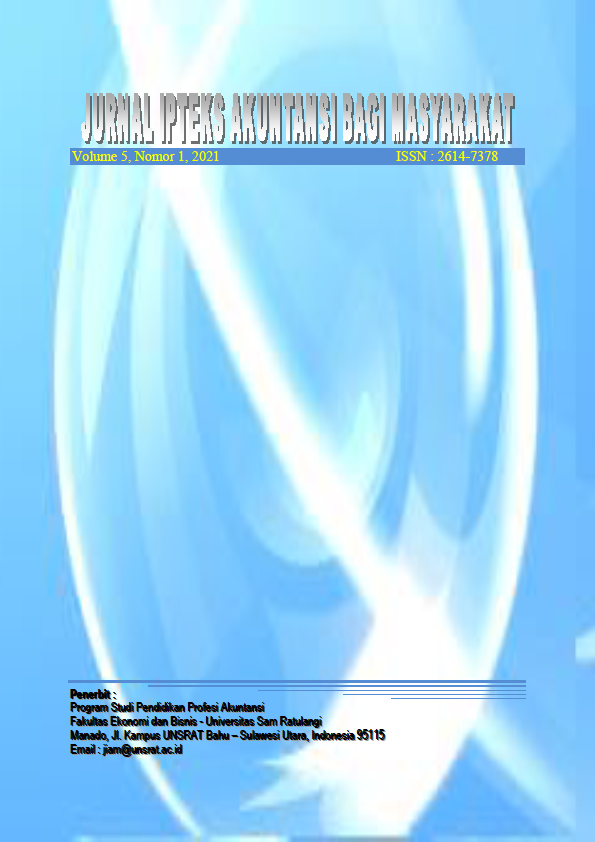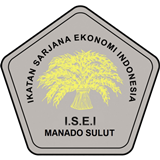PENERAPAN PERENCANAAN PAJAK ATAS PAJAK PENGHASILAN
DOI:
https://doi.org/10.32400/jiam.5.1.2021.34693Keywords:
tax plan, income tax, tax avoidanceAbstract
This study aims to describe how the implementation of appropriate tax planning in order to minimize the payment of income tax. In optimizing tax planning, a strategy that can be done is to make a nominative list related to entertainment expenses, management of food facilities, health and communication for employees, the use of the gross-up method in calculating employee salaries. Tax planning resulted in tax savings of IDR 7,022,500.00. The available cash flow from the tax savings can be maximized to support other operational activities.
References
Alfaruqi, H. A., Sugiharti, D. K., & Cahyadini, A. (2019). Peran pemerintah dalam mencegah tindakan penghindaran pajak sebagai aktualisasi penyelenggaraan pemerintahan yang baik dalam bidang perpajakan. Acta Diurnal: Jurnal Ilmu Hukum Kenotariatan, 3(1), 113-133. http://jurnal.fh.unpad.ac.id/index.php/acta/article/view/216
Damayanti, V., & Wulandari, S. (2021). The effect of leverage, institutional ownership, and business strategy on tax avoidance (Case of listed manufacturing companies in the consumption goods industry period 2014-2019). Jurnal Accountability, 10(1), 16-26. https://doi.org/10.32400/ja.33956.10.1.2021.16-26
Deák, D. (2004). Legal considerations of tax evasion and tax avoidance. Society and Economy, 26(1), 41-85. https://doi.org/10.1556/socec.26.2004.1.2
Dyreng, S. D., Hanlon, M., & Maydew, E. L. (2008). Longâ€run corporate tax avoidance. The Accounting Review, 83(1), 61-82. https://doi.org/10.2308/accr.2008.83.1.61
Fallan, L., Hammervold, R., & Grounhaug, K. (1995). Adoption of tax planning instruments in bussines organizations: A structural equation modelling approach. Scandinavian Journal of Management, 11(2), 177-190. https://doi.org/10.1016/0956-5221(95)00007-I
Inkiriwang, K. G. (2017). Perspektif hukum terhadap upaya penghindaran pajak oleh suatu badan usaha. Lex Et Societatis, 5(4), 13-18. https://ejournal.unsrat.ac.id/index.php/lexetsocietatis/article/view/16072
McLaren, J. (2008). The distinction between tax avoidance and tax evasion has become blurred in Australia: why has it happened?. Journal of the Australasian Tax Teachers Association, 3(2), 141-163. https://static1.squarespace.com/static/5e88791f0c333872e0b33272/t/5ee61f83b3fb1839cc35bbbe/1592139679422/JATTA-2008-Volume3-Issue2-All-Articles.pdf
Muljono, D. (2009). Tax planning: Menyiasati pajak dengan bijak. Yogyakarta: Penerbit ANDI.
Pohan, C. A. (2013). Manajemen perpajakan: Strategi perencanaan pajak dan bisnis. Jakarta: PT. Gramedia Pustaka Utama.
Nugraha, M. C. J., & Setiawan, P. E. (2019). Pengaruh penghindaran pajak (tax avoidance) pada nilai perusahaan dengan transparansi sebagai variabel pemoderasi. E-Jurnal Akuntansi, 26(1), 398-425. https://doi.org/10.24843/EJA.2019.v26.i01.p15
Rahayu, N. (2010). Evaluasi regulasi atas praktik penghindaran pajak penanaman modal asing. Jurnal Akuntansi dan Keuangan Indonesia, 7(1), 61-78. http://dx.doi.org/10.21002/jaki.2010.04
Ratnasari, D., & Nuswantara, D. A. (2020). Pengaruh kepemilikan institusional dan leverage terhadap penghindaran pajak (tax avoidance). Jurnal Akuntansi AKUNESA, 9(1), 1-10. https://journal.unesa.ac.id/index.php/akunesa/article/view/9392
Shafer, W., & Simmons, R. (2008). Social responsibility, machiavellianism and tax avoidance: A Study of Hong Kong tax professionals. Accounting, Auditing & Accountability Journal, 21(5), 695-720. http://dx.doi.org/10.1108/09513570810872978
Undang-Undang Republik Indonesia Nomor 16 Tahun 2009 tentang Penetapan Peraturan Pemerintah Pengganti Undang-Undang Nomor 5 Tahun 2008 Tentang Perubahan Keempat Atas Undang Undang Nomor 6 Tahun 1983 Tentang Ketentuan Umum Dan Tata Cara Perpajakan Menjadi Undang-Undang.
Undang-Undang Republik Indonesia Nomor 36 Tahun 2008 tentang Perubahan Keempat Atas Undang-Undang Nomor 7 Tahun 1983 Tentang Pajak Penghasilan.
Downloads
Additional Files
Published
Issue
Section
License
Authors who publish with this journal agree to the following terms:
- Authors retain copyright and grant the journal right of first publication with the work simultaneously licensed under a Creative Commons Attribution License that allows others to share the work with an acknowledgement of the work's authorship and initial publication in this journal.
- Authors are able to enter into separate, additional contractual arrangements for the non-exclusive distribution of the journal's published version of the work (e.g., post it to an institutional repository or publish it in a book), with an acknowledgement of its initial publication in this journal.
- Authors are permitted and encouraged to post their work online (e.g., in institutional repositories or on their website) prior to and during the submission process, as it can lead to productive exchanges, as well as earlier and greater citation of published work (See The Effect of Open Access).







